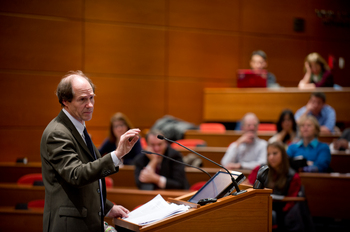
Cass Sunstein explains why – and when – policymakers should use default rules.
In recent years, the National School Lunch Program found itself stuck in a demoralizing quandary: not enough poor children were qualifying, or even applying, for the program because it was too difficult to submit an application. In response, the program administrators, with congressional authorization, instituted a “direct certification” program, by which school districts could initially enroll needy students in the program without requiring them to complete the onerous application process. Thus, poor children were presumed qualified for the program by default unless shown otherwise. A single rule, implementing this change in the “default rule,” brought up to a quarter-million additional poor students into the free lunch program. Other direct certification initiatives are enrolling many more poor students.
At a Penn Program on Regulation seminar held earlier this year, Harvard Law School professor Cass Sunstein discussed the relative merits of default rules – a part of what he calls “choice architecture.” In particular, he examined circumstances that are better suited for default rules and those that are better suited for what he calls “active choosing,” which does not rely on any default settings. He compared “mass” default rules, applied to a large population, with active choosing and “personalized” default rules, applied on a more individualized basis.
Sunstein concluded that if choice architects are informed, capable, and trustworthy, then personalized default rules, suited to individual circumstances, may well be the right choice. But if a relevant population affected by a policy has diverse preferences, likes to choose, or does not trust the choice architect, active choosing is usually the better approach.
The seminar took place in a packed Fitts Auditorium at the University of Pennsylvania Law School, where Sunstein spoke at Penn for the first time since stepping down as the Administrator of the White House Office of Information and Regulatory Affairs.
Sunstein began his talk with an anecdote showing the pervasive use and immense power of default rules. Apparently 99% of Austrians consent to organ donation, while only 12% of Germans do. According to Sunstein, this huge disparity in these neighboring nations is explained by differences in default rules. Austrians are presumed to enroll in the organ donor program by default; Germans, by contrast, are not enrolled by default but must affirmatively opt in.

The power of default rules can be seen in America as well, according to Sunstein. When consumers have to sign up for savings plans – as opposed to being automatically enrolled when signing up for checking accounts – they save at a far lower rate. This phenomenon, Sunstein argued, shows the power of default rules as behavioral “nudges.”
Sunstein explained that the power of default rules comes from their “stickiness.” They tend to have an impact due to one or more of three reasons, he said.
First, inertia helps explain the impact of default rules. Research from Italy, for example, has shown that television programs that follow especially popular programs have artificially high ratings because people tend to stay with the status quo unless they have a clear preference for a change.
Second, the existence of default rules also can generate an implicit endorsement of their value, Sunstein claimed. People may simply trust the choice architect and assume that there is a valid reason behind the default setting.

Finally, the phenomenon of loss aversion amplifies the power of default rules. Professional golfers are more likely to sink putts when they are putting for a par than when they are putting for a birdie. Similarly, a promise of an additional bonus produces is less effective in getting teachers to improve student test scores than a threat of rescinding a previously granted bonus. Such examples, Sunstein said, imply that people are especially resistant to giving up the circumstances of their default setting.
If default rules are so powerful, how should choice architects use them? Carefully, Sunstein proposed. They need to use them in situations that minimize both the cost of errors and the cost of deciding. Applying these decision criteria, Sunstein turned to the relative merits of three types of choice architecture: mass default rules, active choosing, and personalized default rules.
A system based on mass default rules, which sets default settings for an entire population, can increase efficiency in certain settings because it can “nudge” people toward socially optimal behavior, he said. Sunstein suggested that mass default rules also have the benefit of being “freedom-preserving” because, unlike outright bans, people are free to reject the default setting.
Active choosing refers to a system that does not use any default settings but instead allows individuals to choose. On the positive side, active choosing can help people overcome inertia. Sunstein noted that active choosing likely works better in situations where people have private information, so that default rules may go in the wrong direction, or do not trust the choice architect. Furthermore, active choosing works especially well when a high level of customization and diversity is required.
On the other hand, Sunstein argued, active choosing can impose the burden of choosing on people who do not welcome that burden. The burden of choosing is especially onerous when information costs are large. When these costs are high, each individual has to spend time collecting and processing the necessary information, and the risk of errors increases. Thus, active choosing may increase both the cost of making decisions and the cost of errors.
Finally, Sunstein posited that personalized default rules may be “the wave of the future” because they have “the potential to provide the benefits of default rules in general while also providing benefits of active choosing in particular.” Personalized default rules can be designed on the basis of people’s own past choices, making them more likely to be aligned with each individual’s preferences than are mass default rules. Amazon.com’s book recommendations or travel websites’ suggested travel packages offer examples of such beneficial personalized default rules in use in the private sector. Sunstein further explained that personalized default rules can be dynamic as well and shift over time as more information becomes available.
Personalized default rules are not free of potential downsides, Sunstein conceded. A truly effective system of personalized default rules would require the choice architect to collect an enormous amount of information. Also, the choice architect would need access to people’s private information, such as recorded preferences. To this concern, Sunstein responded that choice architects could leave privacy setting as an “active choosing” item that people choose without being defaulted into any setting.
Sunstein’s article on this topic is forthcoming in the University of Pennsylvania Law Review.



